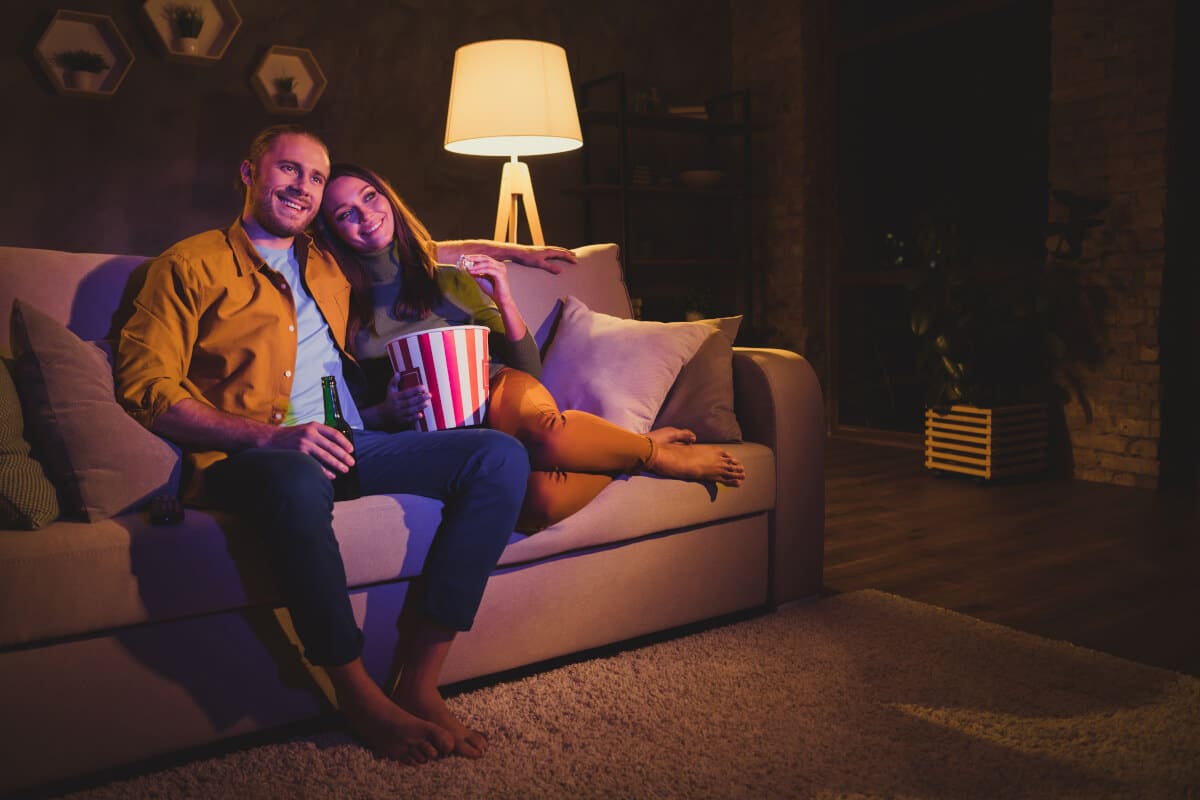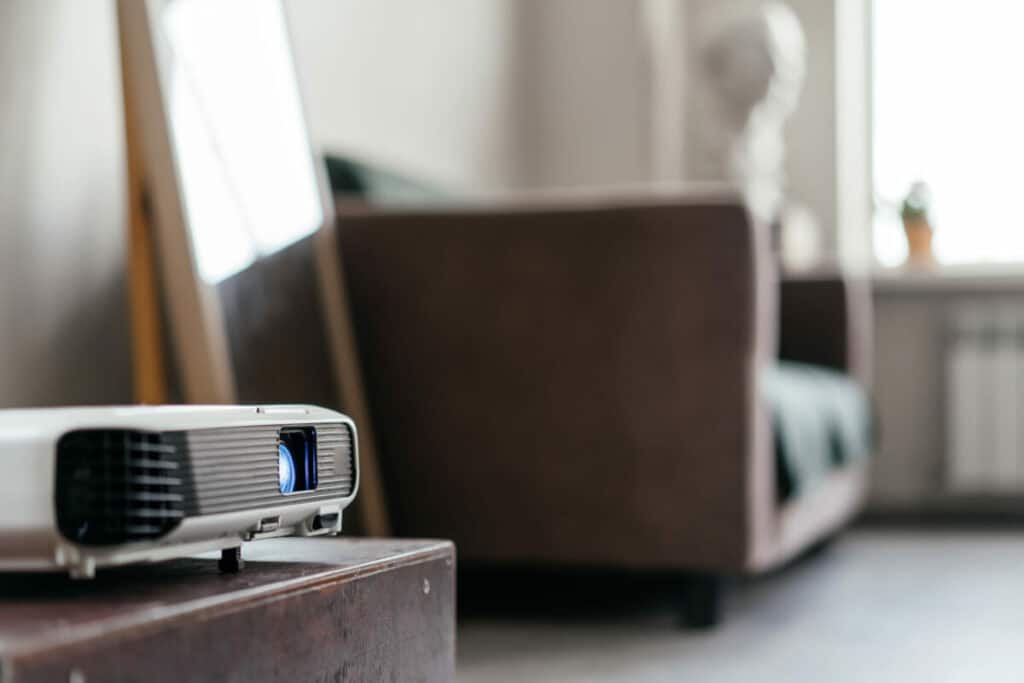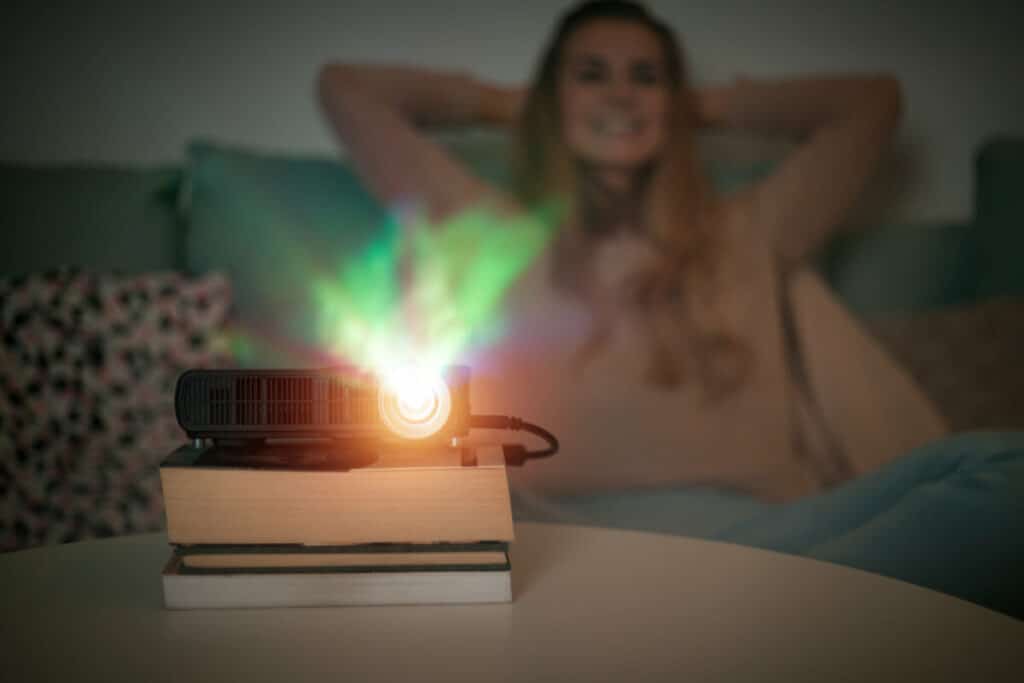the essentials in brief
The size of the canvas should match that of the room.
A good screen is essential for image quality, among other things. You can find out more about the benefits here.
A gray screen absorbs part of the light in the room. You can read here why this is useful.
Screen and projector are the heart of every home cinema. they offer incomparable film experiences, in the comfort of your own four walls. Here we explain which screens are available, what their advantages are and how you can achieve the perfect picture.
Contents
Therefore a screen
“Why even buy a home cinema screen when I can white wall as a projection surface can use?” some people ask. In fact, it's not that easy, because most of the walls are covered with woodchip wallpaper.
The coarser structure, the wallpaper does not reflect the light evenly, but scatters it. A high-resolution image is no longer possible.
In principle, it is possible to plaster the wall smooth and evenly and paint it white. But conventional white wall paint has one yellowness, which distorts the picture. A special projection color can help here.
Unfortunately, their cost exceeds that of ordinary wall paint many times over. In addition, in practice it can never be applied as smoothly as would be necessary for a perfect picture. In short: one Surface Fabric for home cinema is as a projection surface the cheapest and most practical option.

The virtues of the canvas
A screen for home cinema offers numerous advantages over a conventional television or projector, which make up the home cinema experience in a class of its own. Here are some of the key benefits:
- Bigger picture: A home screen makes it possible to project a much larger image than a television. This creates a more immersive and immersive cinematic experience that is closer to going to the cinema.
- Better picture quality: Screens are made of special material optimized for better color rendering and contrast optimization. This makes the picture clearer and sharper than a regular TV.
- Flexibility: A screen can come in different sizes and formats, so that it can be adapted to the size of the room and the user's preferences. In addition, some models can be extended so that they can be stored away if necessary.
- better atmosphere: Home theater screens can help create a better atmosphere in the room. The big picture and roughly the audio quality of a Dolby Atmos system create an immersive environment that helps fully immerse you in the experience.
Tip: A good projector is the be-all and end-all for your home cinema. You should therefore not save when buying the device.
What canvases are there?
An Surface Fabric for one Beamer or a home theater can made of fabric or PVC consist. The quality of the canvas depends on the material and the manufacturing quality.
Fabric models are ideal for projectors and home cinemas as they have a number of advantages over other materials. First of all, screen cloth is for home theater breathable, which means it can regulate moisture better than other types of canvas. This is important as humid environments can affect image quality.
In addition, fabric lighter than other canvas materials and therefore easier to transport and hang up. Also, fabric absorbs light better than other types of canvas, meaning it delivers better image quality. Finally, a home theater screen fabric is also more affordable than other options.
Other screens are off PVC. PVC is a good material for a canvas because it heat resistant and fade resistant is. The surface of PVC has a smooth surface, so that the image appears sharp on the screen. It is also a strong material with excellent durability.
Important: A good canvas should have a high GAIN factor have in order to achieve a brilliant image. It is also important that the canvas is smooth and even so that the image is not distorted.

How do I mount the screen?
The simplest solution is a canvas on a tripod to purchase. Then it can be easily set up and put away again when not in use. On the other hand, there are also some disadvantages here.
First of all, it should be noted that the attachment to the tripod places certain limits on the size of the screen. The larger the canvas, the heavier the construction and the the structure is more complicated.
To consider: At some point, setting up a tripod screen is no longer worthwhile. The constant assembly and disassembly is annoying if you want to organize regular movie nights. But there is a solution for that!
Retractable screens
That's why many choose one Roll-up screen. The screen is rolled up in a corresponding box and is simply pulled down when required. Such retractable screens for home cinema can easily be flexible attached .
Optionally, attach the suspension on the blanket or the wall. The type of suspension and the total weight of the construction must be taken into account here. Especially when attached under the blanket it is important that she can bear the weight. But the wall should also be stable enough for it.
Some roll-up screens are available with one engine and can be extended at the push of a button. These electric projector screens are a particularly convenient option. Extendable models save space and protect the canvas from dirt and damage.
Most screens are off special materials manufactured that are optimized for projecting images so that they deliver a crisp and bright image.
A retractable screen can be used for many applications, e.g for presentations, movies, video games or for projecting artworks. It's a convenient and flexible way to create a larger image than is possible with a regular screen or monitor.

The perfect image on the screen
How can a screen be optimally used to achieve the best home cinema effect? Three factors are decisive here. First hers Size, which depends on the distance to the projector and the seating position, you Format and the GAIN factor.
Tip: A rule of thumb states that the diagonal of the screen should be about twice the distance between the projection surface and the seating position. So if the distance between the projector and the screen is 3 meters, the diagonal of the screen should be 1,5 meters. However, the actual size of the image to be projected must also be taken into account here.

The format
As for the format, usually between the 16:9 and 4:3 format distinguished. Which format you choose depends largely on the Resolution of the projector.
Who one Full-HD Beamer calls his own, is with a screen in the 16: 9 format well advised, as this fully utilizes the native resolution of the device.
At a shorter distance to the picture can do that 4: 3 format can also be a good choice as it is a bit smaller and the image doesn't look as distorted.
The gain factor
key fact box
The GAIN factor quantifies the reflectivity of a surface.
Finally, there is the one mentioned GAIN factor. What is behind this designation? The GAIN factor is nothing more than the reflectivity or the luminance factor the surface.
The higher the GAIN factor, the more light is bounced off the screen and the brighter the image appears on the screen. A high GAIN factor is especially important when you are in a Room with lots of ambient light projected, otherwise the image will quickly be disturbed by ambient light.
Another important point is that the GAIN factor also Contrast ratio affected. This means bright areas of the image appear lighter and dark areas of the image appear darker.
Therefore, when choosing a screen, you should always make sure that the GAIN factor is as high as possible in order to achieve high contrast. Screens with one are sufficient for home cinema GAIN factor of 1,0 , 1,3 or 1,8.
There are also screens with a GAIN factor of 2,5, but these are usually only suitable for professional applications in dark rooms with perfect lighting.
Note: Be sure to match your choice of screen to the room conditions.

What is important is the GAIN factor as homogeneous as possible is. This means that the reflectivity of the screen remains the same everywhere and the light is emitted in the same direction.
Otherwise it can happen that you have a razor-sharp image when you sit in a straight line in front of the projection surface, but this effect is lost as soon as the angle changes.
After all, you want the perfect home cinema experience with the whole family a good picture from every sitting position to have.
Additional information: In rooms that are more difficult to darken, a screen with a dark-coated back can be useful. It is opaque. A gray screen, for example, is specifically designed to improve contrast ratio and black levels when projecting. Unlike a white screen, which reflects light and thereby brightens the image, a gray screen absorbs some of the light and reduces the brightness of the image.
The heart of the home cinema
For regular movie nights with cinema feeling a suitable screen is simply a must. The key is to think about where to install it beforehand. Then you can choose the right size and type of installation. Keep our tips and facts in mind, then nothing can go wrong with your canvas!
FAQ - Canvas
There are tripod screens and roll-up screens. Tripod screens stand on a frame and are set up when required. Roller screens are fixed to the wall or blanket mounted and can be pulled down. Some can be extended electrically.
The most important points are the size of the screen, its format and the distance between the screen and the projector.
The GAIN factor indicates how much light the screen reflects. The higher, the better the picture. The GAIN factor should be as homogeneous as possible over the entire area.

